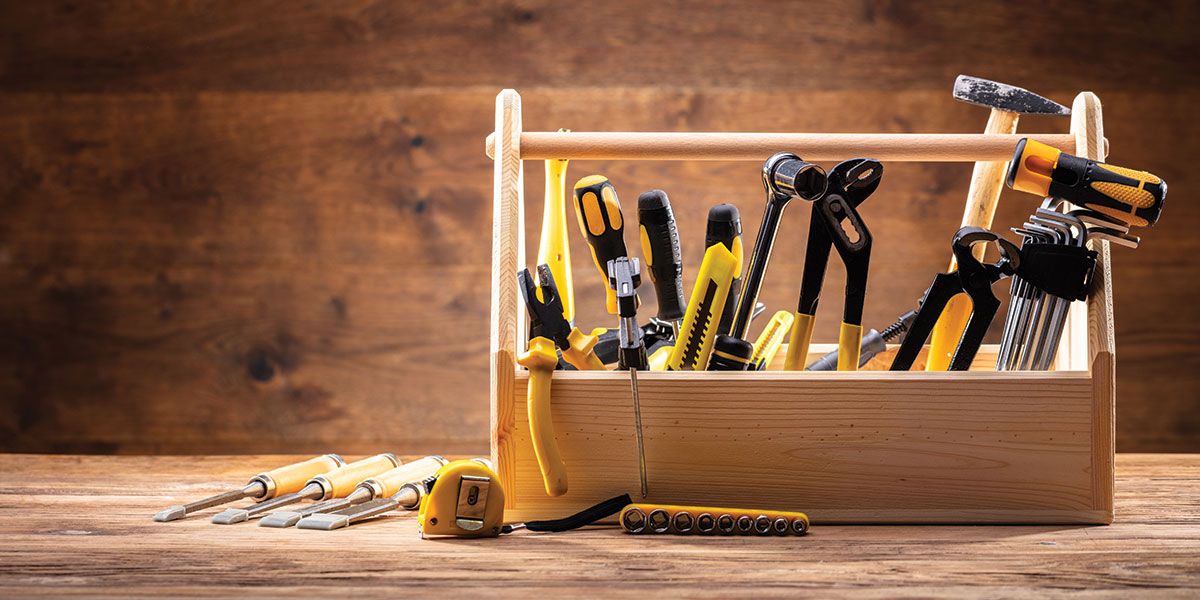DIY YOUR SPACE

Setting up a home workshop
Having some type of home workshop is a must for most homeowners. For some, puttering with tools that can make and fix things is therapeutic. For others, the ability to manage simple and moderately-challenging home improvement and maintenance tasks is convenient and precludes the need to pay a pro whenever something needs repair. Still, others take working with their hands to the hobby level and beyond, making furniture or functional and decorative objects out of rare and beautiful wood or undertaking home renovations.
Here are a few ideas for equipping and organizing this space.
Utility & space
First, think about how you might use a workshop; the most useful shops are designed and equipped with a clear vision of what will be accomplished there. Think it through — for the near term and allowing for expansion as your interest and skills develop.
Next, consider the location and size of your shop. A corner of the garage or basement can be sufficient for organizing and storing common DIY tools. A sturdy workbench — either home-built or purchased at a home improvement center — typically has at least one lower shelf for tool boxes. Square, heavy-duty plastic “milk bottle” crates, available at home improvement stores or even as file boxes at office supply outlets, hold oodles of tools or supplies and will fit on the shelf or slide easily under it. A pegboard or mid-range cabinets above the workbench will keep tools organized within easy reach.
The tools
A table saw, either portable or fixed, is the cornerstone of any woodworker’s shop. Working with long planks, moldings and sheets of plywood, composite, masonite or paneling will require space for infeed and outfeed support platforms. Serious woodworkers will add a joiner (for creating true edges on wood stock), planer (for smoothing wood surfaces) and router (for hollowing out, creating edges, decorative scrolling, etc.). A drill press, band saw or chop saw (for precisely cutting trim moldings, frame corners, etc.) complement your collection. Radial arm saws, good for cross and angle cutting, are notorious for projectile incidents when ripping long boards.
“The best lathe,” says master DIY guy Rick McKown of Moneta – a retired mechanical engineer who can build or fix about anything around a home, “belongs to a friend who’s really into woodturning. Unless that’s your passion, you don’t need your own.”
McKown also recommends creating an inventory of glues, wood and machine screws, bolts and nuts, dry-wall anchors, wood fillers, patching compounds and the like. “Minor jobs become major time consumers when you have to repeatedly stop working and run to the hardware store for what you need.”
Tools every workshop needs
Here are some of the tools and equipment that are handy to have for basic woodworking and miscellaneous home fix-ups:
- Saw horses
- Tape measure
- Calipers
- Straight-edge metal ruler and square; carpenter’s pencil
- Stable work table with vise
- Cordless drill/impact driver combo
- Nail gun and “pancake” compressor plus several sizes of nails
- Hand saws – cross cut, rip, coping and hack saw for metal
- Claw hammer
- Hand plane
- Level
- Mallet and assorted chisels
- Variable speed palm sander and selection of sandpaper
- Fine and course grinder
- Assorted screw drivers, both flat and Phillips-head
- Pliers (standard, needle nose), adjustable locking gripper
- Wire cutter
- Swiss-Army style pocket knife
- Jig saw
- Vibrating or oscillating multi-cutter
- Squares, clamps and level
- Wood rasp and metal files
- Quality all-in-one tool kit with selection of drill bits, sockets, box and open-end wrenches, Allen wrenches, nut drivers, etc.
- Tool bucket or tray, bag or belt (also for taking needed tools to work location)
- Tin snips
- Soldering iron
- Caulking gun
- Glue gun
- Shop vac
- Stool and perhaps rubber mat if floor is concrete
- Safety glasses, dust mask, ear plugs, leather gloves
- First aid kit
Workshop location
Because of the noise and dust workshop power tools produce, the further from other living spaces you can locate them the better. A separate shop building is ideal, but a portion of the basement – walled off to contain dust and noise – is likely a more-practical option.
Having a workbench and common mini-fix tools (pliers, screw drivers, box cutter, X-acto knife, Allen wrenches, socket set, nut drivers or box wrenches, etc.) in the garage is handy, but “… putting woodworking machinery there is simply asking for fine layers of dust to blanket cars, garden tools, and whatever else resides in the garage,” McKown cautions.
Power saws and dust collection systems are noisy, so think through the impact they will have on others in the household. Also consider the electrical service you’ll need: will a woodworking machine require a 220-volt circuit? At the very least, you’ll want several outlets or a quality power strip within easy reach of your workbench top for plugging in tools, charging batteries and powering the lighting to illuminate your work area. Good overhead lighting, by the way, is key to a safe workshop environment.
Your workshop will be home to the many tools you already own, and you’ll be adding some needed for future projects. Don’t be tempted by bargain-bin brands. Instead, spend what it takes to acquire quality hand tools, power tools with brushless motors and ball bearings instead of bushings, and longer-lasting batteries. Cheap tools are rarely up to the task, won’t last and may not be safe to use. Quality tools make jobs go smoother, will last nearly a lifetime, and may well preclude a trip to the emergency room! Online research about what you intend to buy is an excellent use of your time.
Now, get to work! ✦
drill press, dust collection systems, home improvement, home workshop, maintenance tasks, power saws, Radial arm saws, table saw, tools, utility & space, workshop location








